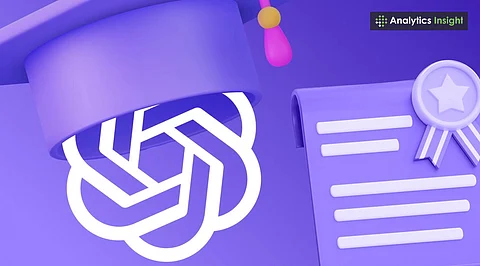

ChatGPT is going beyond homework solutions with the newly released Study Mode.
OpenAI has released a new model designed to integrate into the education system, helping students with a genuine learning process.
ChatGPT-5 is also rumored to come sometime in 2025, but critics are taking a risk with it.
In the advancing AI era, ChatGPT has established a significant presence in the academic sector, assisting students with their daily papers and theses. However, this AI tool has long been criticized for being a homework completion machine, a high-risk shortcut that disrupts genuine learning.
The arrival of the new Study Mode is changing this scenario, with OpenAI actively preparing to make ChatGPT a learning companion that will foster understanding, encourage curiosity, and promote critical thinking.
After the team visits India, where the tutor culture is deeply rooted in the education system, the Study Mode reframes the AI from a mere answer tool to a guided tutor.
On July 29, OpenAI launched ChatGPT Study Mode, which is aimed at redesigning the framework of the AI tool. Immediately after the launch, this new mode made its way to different versions of the LLM, including Free, Plus, Pro, and Team ChatGPT. Soon, it will be accessible to ChatGPT Edu users.
The introduction of this new mode replaces direct answer delivery with analytical questions, personalized feedback, and incremental learning. Instead of providing instant essays or solutions outright, the AI now prompts students to think, reflect, clarify, and learn through guided interaction.
This model is built in collaboration with around 40 institutions and pedagogy experts globally to include steps like knowledge checks, reflective prompts, and explanations customized according to skill levels.
Though critics are concerned about the ease of switching between modes, OpenAI has highlighted that this is what makes ChatGPT constructive for students, instead of a simple academic shortcut.
Also Read: How to Get Better Responses from ChatGPT with Quick Fixes?
Currently, the tech world is buzzing over the rumored November launch of ChatGPT-5. Despite this, the developer confirmed nothing about this timeline, and there are no verified details of this chatbot model; insiders suggest the upcoming GPT-5 will be more integrally related to the education features.
Expectations are going wild about it, offering reasoning, real‑time feedback, and support for collaborative learning scenarios. Some enthusiasts believe OpenAI has been revising the AI agent, which is pushing the release time further.
Other theories suggest that an ‘education-aware GPT’ model will likely be launched under the ChatGPT Edu umbrella, merging research-grade reasoning with pedagogical scaffolding. Well, none of these have any solid basis to talk about at this point.
The introduction of Study Mode marks a promising uprising of ChatGPT, indicating OpenAI recognizes the requirements of AI assistance in learning. Considering this scenario, the tech giant has been trying to bring a new model that will fit behavioral and instructional design and push students toward deeper engagement.
Notably, critics and industry insiders are still worried about ChatGPT‑5, and they want OpenAI to focus on a more incremental and cautious rollout. With upgrades like GPT‑4.5 and ChatGPT Agent, the company has enhanced reasoning capabilities, but these models still fall short in fully validated integration into curricula or seamless classroom workflows.
However, ultimately, the success of this educational shift depends on adoption, not only by the students but also by institutions and educators across the world. To date, many schools and academic institutions are worried about AI use, considering the risk of plagiarism, bias, and dependency on technology.
Also Read: How ChatGPT Became a Digital Co-Worker from Chatbot?
OpenAI’s plan to evolve the newly launched Study Mode through further pedagogical refinements will probably alter its core behavior and turn GPT toward a genuine educational infrastructure. Still, achieving this feat depends on active oversight of clear guidelines, educator training, academic policy shifts, and equitable access.
To sum up, the move toward education AI support is commendable and a genuine step forward in integrating ChatGPT into the education system. However, what matters more is whether tools like Study Mode can reimagine learning, assessment, and the educator’s role in an AI‑augmented world.
How can ChatGPT be used for personalized learning and adapting to individual student needs?
Ans: ChatGPT provides tailored explanations, resources, and feedback, adapting to each student’s learning pace and style. It facilitates personalized support, boosts engagement, and helps students with diverse needs, making learning more effective and accessible for all.
How does ChatGPT support teachers in lesson planning?
Ans: Teachers use ChatGPT for lesson planning, creating quizzes, and generating study materials. It streamlines administrative tasks, assists with grading, and offers quick content ideas, freeing up valuable time for educators to focus on classroom interaction and mentoring.
Can ChatGPT be used as a tutor for students outside of regular class hours?
Ans: ChatGPT can act as an always-available tutor, providing instant clarifications, practice questions, and explanations. It supports self-paced study and exam preparation, improves language and writing skills, and offers guidance outside traditional school hours, empowering independent learning.
How does ChatGPT enhance collaborative or project-based learning experiences among students?
Ans: ChatGPT encourages collaborative learning by facilitating group discussions, brainstorming sessions, and project planning. It can help structure teamwork, provide real-time feedback, and support student-driven inquiry, enhancing communication and interactive skills essential for future-ready learning environments.
What are the main ethical concerns and limitations of incorporating ChatGPT and AI tools in educational settings?
Ans: Ethical concerns include academic honesty, plagiarism, over-dependence on the tool, and data privacy issues. Limitations include uneven access, the potential spread of incorrect information, inadequate development of critical thinking, and the necessity for careful human oversight to ensure responsible use in education.
